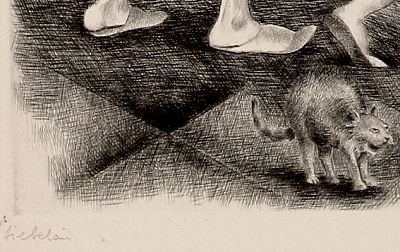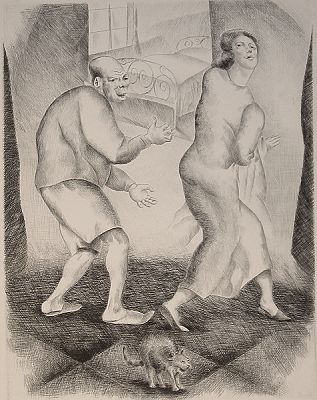|
Table of Contents
To navigate this catalogue raisonné, choose from the links below. |
|
Thumbnails, Part 4:
Prints made for Illustrated Books (These prints are not included in the catalogue raisonné proper.) |
|
A Biographical Chronology
of the artist (and its accompanying linked pages) appears on the website The Art and World of Luis Quintanilla |
|
To navigate
The Fiene Quintanilla Online Catalogue Raisonné Project, use the links below. |
| Useful Links |
| Quintanilla Copyright ©2006, Jeffrey Coven, CATRAIS Copyright ©2010 IA\TPC |
A Catalogue Raisonné
(in progress)
Title: Liebelei**
Series: Madrid Prints
Date: 1931-34***
Medium: Drypoint, possibly including some etching****
Edition: 7 numbered impressions plus at least one unnumbered impresssion*****
Dimensions: 360 x 280 mm. (14 3/16 x 11 in.)
Printer: Adolfo Ruperez
Paper: Wove with Arches watermark
Signature: Typically signed in pencil, l.r., beneath the plate mark.
Public collections holding this print: FBA
Topic galleries for this print:
1. Couples
2. Interiors (domestic)
3. Performance, Entertainment and Celebration
4. Scenes Featuring Animals
*Catalogue Entry #: For numbering used in other catalogues, see below.
- The Pierre Matisse Gallery Catalogue # = 31
- The Universidad de Cantabria "Luis Quintanilla" catalogue # = 1
**Title:
- The title, "Liebelei" (the German word for "flirtation" or "affair") appears in the artist's hand in pencil (somewhat illegibly) on at least one impression, beneath the plate mark, l.l. (See fig. 1 below.)
- The only known impressions bearing titles in the artist's hand for Madrid Series prints are in the Hemingway Collection and carry their titles l.l. where the numbering normally appears.
- "Liebelei" appears in an unknown hand at the bottom of the sheet of two other observed impressions, neither of which bear a title in the conventional place.
- The Universidad de Cantabria 2005 exhibition catalogue "Luis Quintanilla" and FBA also use the title "Liebelei."
The Pierre Matisse Gallery exhibition catalogue (1934) uses the title "Jugueteos" ("Cavorting").

fig. 1

fig. 2
- A film directed by Max Ophuls with the title Liebelei, based on a play with the same title by Arthur Schnitzler, was released in Germany in1932. The film opened in Paris in May, 1933. (In fact, Ophuls was pleased to see it still playing in Paris when he arrived there while fleeing the Nazi's later that same year.). Reportedly, the film opened in the provincial city of Santanter, Spain (Quintanilla's home town) in December, 1933, with the Spanish title "Amorios" (in English "a fling"). More likely than not it would also have been shown in Madrid about this same time, a period corresponding to the time of the creation of this print. Critics of the film commented that Ophuls changed Schnitzler's story from one of cruel male sexual exploitation of female feelings to one of tragic true love. If this is true, the content of Quintanilla's image makes his title more likely an allusion to Schnitzler's play; though given the coincidence in time between the showing of the film in Spain and the creation of the print, a connection to Ophuls' film is likely as well. The artist was known to be a devotee of both the theater and the cinema.
***Date: No date appears on any observed impression of this print. Of the dates that appear on works in the Hemingway Collection, which includes this print, none is earlier than 1931 and none later than 1934. Quintanilla started making drypoints, in fact prints in general, with Adolfo Ruperez, the printer of all the prints in the Madrid Series, sometime after the artist's return to Madrid in 1929. (See Biographical Chronology.)
- The one known exception to the range of dates specified in the paragraph just above is entry # I.
****Medium: A final determination for the medium has not been made.
- For a discussion of the factors involved, visit the "Medium" section of "Using This Catalogue Raisonné."
*****Edition:
- One impression is inscribed below the plate mark, l.l., "7 - P. no -1-"; p=prueba (proof). (See fig. 2 above.)
- Ruperez typically printed ten or fewer (most commonly 7-10) of Quintanilla's Madrid Series prints, often including at least one unnumbered impression outside the edition.
- The Hemingway Collection typically includes one unnumbered impression bearing a title instead of the number, l.l. (See Fig. 1 above.)
Reproduced in: "Luis Quintanilla" (Universidad de Cantabria) (39)
